Blogroll
- Meals I Have Eaten
- Jess's New Blog
- One of Jess's Old Blogs
- The Stop Button
- Jenerator's Rant
- The Rejection Collection
- Pockets Stuffed With Notes
- The Silkie Road
- PostSecret
- Informed Comment
- Talking Points Memo
- Spoken & Heard
- Ever So Strange
- that-unsound
- Marvelous Prompts (& Responses)
- Only Words To Play
- So Misunderstood
- Acknowledge & Proceed
Profile & Email
Previous Posts
- don't pine for me, alaska...
- on the surprise of a best friend's marriage
- feckin fishin faq #2: eye care
- 30? Holy Crap!
- teaching superstar
- yellow plums & parking tickets
- feckin fishin faq #1: the igloo
- intrepid & stoic fisherperson
- don't worry, i'll let you feel my abs later...
- Z 4th grinded in salt
Archives
- April 2005
- May 2005
- June 2005
- July 2005
- August 2005
- September 2005
- October 2005
- November 2005
- December 2005
- January 2006
- February 2006
- March 2006
- April 2006
- May 2006
- June 2006
- July 2006
- August 2006
- September 2006
- October 2006
- November 2006
- December 2006
- January 2007
- February 2007
- March 2007
- April 2007
- May 2007
- June 2007
- July 2007
- August 2007
- September 2007
- October 2007
- November 2007
- December 2007
- January 2008
- February 2008
- March 2008
- April 2008
- May 2008
- June 2008
- July 2008
- August 2008
- September 2008
- October 2008
- November 2008
- December 2008
- January 2009
- February 2009
- March 2009
- April 2009
- May 2009
- June 2009
- July 2009
- August 2009
- September 2009
- October 2009
- November 2009
- December 2009
- January 2010
- February 2010
- March 2010
- April 2010
- May 2010
- June 2010
- July 2010
- August 2010
- September 2010
- October 2010
- November 2010
- December 2010
- January 2011
- February 2011
- March 2011
- April 2011
- May 2011
- June 2011
- July 2011
- August 2011
- September 2011
- October 2011
- November 2011
- December 2011
- January 2012
- February 2012
- March 2012
- April 2012
- May 2012
- June 2012
- July 2012
- August 2012
- September 2012
- October 2012
- November 2012
- January 2013
- March 2013
- May 2014
n. infantile pattern of suckle-swallow movement in which the tongue is placed between incisor teeth or between alveolar ridges during initial stage of swallowing (if persistent can lead to various dental abnormalities) v. [content removed due to Bush campaign to clean up the internet] n. act of nyah-nyah v. pursuing with relentless abandon the need to masticate and thrust the world into every bodily incarnation in order to transform it, via the act of salivation, into nutritive agency
Sunday, September 03, 2006
feckin fishin faq #3: breeding
Wait, wait, wait, my furry fisherwoman friend. You lived in a Pink Igloo and went out on a tiny little skiff. Just what kind of fishing is this "setnetting" and does it qualify you for Kungfu Fisherman Status?
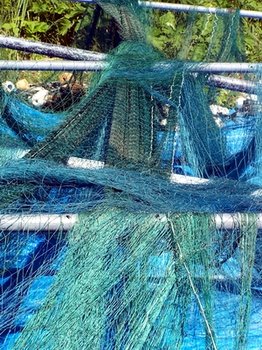 Excellent questions, all of them. And I managed to find some cute little drawings on the web to help me explain all this (the pics are mine).
Excellent questions, all of them. And I managed to find some cute little drawings on the web to help me explain all this (the pics are mine).
Well, there are quite a few different forms of fishing, even within the United States and not taking into consideration all the other types of fishing around the world including those folks in Ecuador I saw who swam around sticking their hands into underwater crab holes, catching the crabs when they bit, and then wrapping them around their necks on ropes they used to bundle the crabs together (lei fishing?). But within the US, fishing tends to fall into a few different categories with each boat and captain having his or her own tricksies and secrets that make their operation unique in technique and certainly style. Here are the different kinds, and I'm just talking about what I know off hand, so I might fuck up some of the facts, but deal with it.
Most common for summer fishing in the Kodiak areas... and Alaska I believe... is seining, sometimes known as purse seining. Seining is so popular because seiners are mobile, so they can skootch around the island following the currents and hunting for the influx of seasonal fishes.
This is pretty important because fish don't have rigid habits like stock exchange MVPs who run around in their business suits. Instead, fish tend to be highly influenced by such forces as water temperature, winds, currents, predators, and so forth. But salmon in particular do have one very specific goal in their tiny little minds: their river, where they get to fuck once and then die. So, as a fisherman, you have to understand that the fish will, at some point in time, show up in a specific place to boing their brains out (although in different quantities each year). It's mostly about negotiating being at the right place at the right time. Sometimes you have the "trickle effect" with salmon, but most often, those wily little beasts will not show up, not show up, not show up, and then BAAAAM!, there they'll be for a day or two and then they've fucked and are dead. It's not good karma or produce to sell those salmon who have already dropped their load and are now decomposing at the bottom of the riverbed, although I know a few bears who would disagree with me.
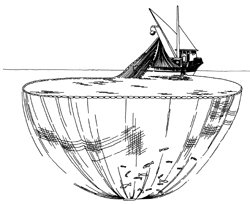 Okay, back to seiners. Seiners can follow those little dudes around if there's a savvy and clever captain who knows the waters well enough. This captain might show up at one river mouth at the right time, and then move on over to another cape at the right time, and so forth. A bad seiner (like the one I was on 8 years ago for 2 weeks until I jumped ship and waved so long... that's another HUGE story though) will do quite the opposite and will follow other boats around and show up too late and at the wrong places and it all sucks.
Okay, back to seiners. Seiners can follow those little dudes around if there's a savvy and clever captain who knows the waters well enough. This captain might show up at one river mouth at the right time, and then move on over to another cape at the right time, and so forth. A bad seiner (like the one I was on 8 years ago for 2 weeks until I jumped ship and waved so long... that's another HUGE story though) will do quite the opposite and will follow other boats around and show up too late and at the wrong places and it all sucks.
Basically, the seiner is composed of two boats: a medium-sized one with a cabin on it, and a skiff like the one we use for setnetting, only burlier. The skiff pulls the net off the back of the boat. Each end of the net is connected to either the skiff that is pulling, or the medium-sized boat that is holding position. The two boats yank the net tight for a while, and then the skiff brings the net around in a circle and re-attaches it to the medium-sized boat. The bottom of the net is then cinched up like a belt (thus the "purse" part of seining), and then begins the long, hard work of pulling the net back up onto the deck of the medium-sized boat (two-three people stack and pile it as it comes up). Finally a bag-o-fish will be near the side of the boat, and that is then lifted via pulley (called the block) onto the boat and into the hold.
The advantages of this type of fishing are mobility and decent quality of fish and the possibility of great bulks at a time. The disadvantages are a fair amount of bycatch (fish, etc., that can't be sold or kept and thus must be thrown overboard, dead or not), the nebulous worries of mobility, and a fairly high overhead especially in terms of gasoline needed to motor around. Both salmon & herring are caught through seining, and probably lots of other types of fish that swim near the surface or not too far down.
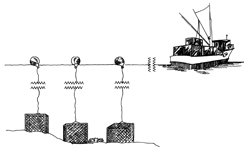 Two types of fishing that seem related to me are long-lining and crabbing. Crabbing involves having a line with a bunch of attached crabpots sitting on the ocean floor and a bunch of buoys at the top marking where they are. Long-lining is similar but instead of crabpots at the bottom, there’s a bunch of baited lines hanging down and waiting for bites and nibbles. Crabbing is obviously good for crabs, and long-lining is used for fish like halibut that tend to move further down near the bottom of the ocean.
Two types of fishing that seem related to me are long-lining and crabbing. Crabbing involves having a line with a bunch of attached crabpots sitting on the ocean floor and a bunch of buoys at the top marking where they are. Long-lining is similar but instead of crabpots at the bottom, there’s a bunch of baited lines hanging down and waiting for bites and nibbles. Crabbing is obviously good for crabs, and long-lining is used for fish like halibut that tend to move further down near the bottom of the ocean.
Advantages and disadvantages of this type of fishing are similar to those of seining, although you are really bringing in one or two fish at a time in long-lining. But there is not very much bycatch in this type of fishing… every now and then a seal or shark will take the long-line bait instead of the halibut, but at least you’re not gathering great gobs of bycatch at a time.
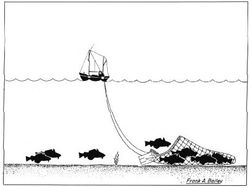 The “evil” form of fishing as I think of it, is trawling, which is also sometimes called dragging because they drag a net on the ocean floor. This is “evil” because it does incredible damage to the seabed – uproots and destroys whole ecosystems, and takes everything living in its way. There are types of trawling that are less damaging to the environment (due to the shape of the net), but overall, I still think it’s pretty sucky. I think there are fewer trawlers than other types of boats in the States… I’m guessing it’s regulated enough to make it less sparkly for the fishermen… but it is still used a great deal by Japanese and Russian fishermen, who often fish just outside of our regulated coastal waters and have sometimes overfished the near waters enough to have hugely affect our fishing industry. I don’t know enough about how they are regulated by their own countries in this day and age, but I do think both have far less oversight than we do (hoorah for the Fish & Game, who keep our waters as alive and sustainable as possible… this is what my brolaw does for a living). What I do know is there’s a fair amount of tension between Alaska fisherman and Japanese/Russian ones, although I don’t really think the two meet super-often.
The “evil” form of fishing as I think of it, is trawling, which is also sometimes called dragging because they drag a net on the ocean floor. This is “evil” because it does incredible damage to the seabed – uproots and destroys whole ecosystems, and takes everything living in its way. There are types of trawling that are less damaging to the environment (due to the shape of the net), but overall, I still think it’s pretty sucky. I think there are fewer trawlers than other types of boats in the States… I’m guessing it’s regulated enough to make it less sparkly for the fishermen… but it is still used a great deal by Japanese and Russian fishermen, who often fish just outside of our regulated coastal waters and have sometimes overfished the near waters enough to have hugely affect our fishing industry. I don’t know enough about how they are regulated by their own countries in this day and age, but I do think both have far less oversight than we do (hoorah for the Fish & Game, who keep our waters as alive and sustainable as possible… this is what my brolaw does for a living). What I do know is there’s a fair amount of tension between Alaska fisherman and Japanese/Russian ones, although I don’t really think the two meet super-often.

Another less-used type of fishing is trolling, which uses baited lines pulled behind a boat. This type of fishing absolutely does not produce a large volume of fish, and I think of it as more often used by sports fishermen than commercial ones. But the fish quality is super-good, so it makes sense for expensive fish that are sold beautifully whole and packed on ice in our ritzy markets.
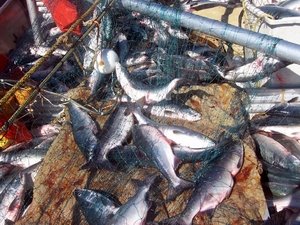 Okay. Now for myyyyyyyyyyyy type of fishing—setnetting, which is also known as gillnetting. This is internationally a very common type of fishing because basically you pop a net out somewhere and then you go out X-amounts of times per day and hand pick all the fish out of the net. It’s pretty fun to do it for subsistence fishing – you catch more than with a rod and reel, but it doesn’t have to be gruesomely hard. In Alaskan setnetting, one end of the net is always anchored to shore, and the other end extends out no further than 200 fathoms and then is anchored to the ocean floor.
Okay. Now for myyyyyyyyyyyy type of fishing—setnetting, which is also known as gillnetting. This is internationally a very common type of fishing because basically you pop a net out somewhere and then you go out X-amounts of times per day and hand pick all the fish out of the net. It’s pretty fun to do it for subsistence fishing – you catch more than with a rod and reel, but it doesn’t have to be gruesomely hard. In Alaskan setnetting, one end of the net is always anchored to shore, and the other end extends out no further than 200 fathoms and then is anchored to the ocean floor.
We have two types of nets we use in tandem—a lead net, which is allowed to be 50 fathoms and does not catch fish—it has too small a mesh size and is super thick, the same stuff seiners use to baggy up their fish—but instead “leads” the fish away from the shore and into the gillnet. The gillnet is translucent green-blue net with mesh roughly sized to fit around the salmon’s gills if they rush head-long into the net. Salmon vary in size, so depending on what type of salmon you are shooting for (whatever’s in your area), so too will your mesh size. The top of the net is held up by corks or bobbers, and the bottom of the net is weighted down with a heavy-ish line called the lead-line (because it is weighted with lead).
 If you fish in the same area for any period of time, which most setnetters do… year after year with some mobility within the bay… then a system of lines, buoys, and anchors is used to fix the net in one place. This is called the running line. Our running line has two anchors holding the end, two anchors holding the hook in place, and three side anchors holding the stem in place. The hook is the ocean-end of the net, which is arranged into a hook shape, and the stem is the straightish line of net--attached at the one end to shore--leading up to the hook. The hook always catches most of the fish, for a similar reason to why crabpots work—hard to find a way out of.
If you fish in the same area for any period of time, which most setnetters do… year after year with some mobility within the bay… then a system of lines, buoys, and anchors is used to fix the net in one place. This is called the running line. Our running line has two anchors holding the end, two anchors holding the hook in place, and three side anchors holding the stem in place. The hook is the ocean-end of the net, which is arranged into a hook shape, and the stem is the straightish line of net--attached at the one end to shore--leading up to the hook. The hook always catches most of the fish, for a similar reason to why crabpots work—hard to find a way out of.
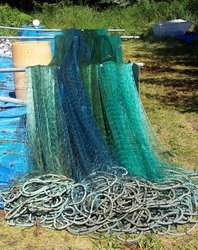 Setnetters are allowed 150 fathoms of gillnet with one permit… and can split that amount into no more than two nets if they choose. Most people do split it up because it means you can have two hooks, and again, the hooks catch the most. But you can also fish two separate locations and catch different quantities of fish in those nets over a period of time. Quite a few gillnetters will have one net always in a fixed spot, and one net they might move around to experiment in finding the fish.
Setnetters are allowed 150 fathoms of gillnet with one permit… and can split that amount into no more than two nets if they choose. Most people do split it up because it means you can have two hooks, and again, the hooks catch the most. But you can also fish two separate locations and catch different quantities of fish in those nets over a period of time. Quite a few gillnetters will have one net always in a fixed spot, and one net they might move around to experiment in finding the fish.
At our site, we have two nets—one 50-f, and one 100-fathom—both of which haven’t changed locations in a bajillion years because the woman who runs the operation is a “little” scared of change. We used to move them around in search of the fish, because we are very much a low-end site fishing the low-end salmon (pinks), and we really should stay on our toes more in order to stay in the rat-race. But that’s a different FAQ. Or five.
But… In order to get the fish from the gillnet, we have two different systems: picking over the side and rolling. We always pick the hook over the side, using a rail to pull the net up bit by bit and get the fish out. And we usually roll the stem. To roll the stem, we pull up a whole boat-length of the net, bring it on board, and then put it in the rollers. The rollers are situated at the front and back of the boat, and basically, we just use the engine to motor the boat “underneath” the net, pulling it up at the front of the boat and letting it off at the back. We can then save our muscles by not pulling, and just pick a boatlength of fish at a time, or grab and pick them as they come by. (See below: rolling on your left, over the side on your right).
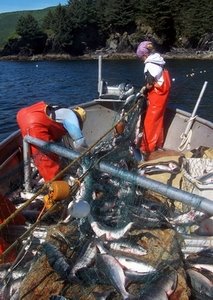
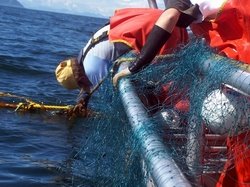
The advantages of setnetting are its stability, lower overhead, and it also tends to be less dangerous and more attractive to families, all of whom can come out and live in the cabin and participate in the fishing to varying degrees. The fish quality can be pretty decent, but if the fish are caught past their gills, the meat of the fish is damaged. Bycatch is very low in gillnetting though. A last disadvantage is that we catch less fish than the seiners do, but since overhead is lower, it sometimes has comparable gain.
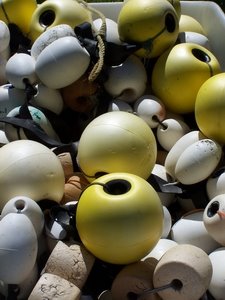 Anyhow, I guess I should mention I’ve been doing this on and off since I was 15 years old… my mom started the site because “she wanted to,” but then had to leave it five years later because on the money our site earned, she could not make a living and support her two great kids as a single mother. So her half-half business-partner took over the site (they were supposed to sell it, but for many reasons this didn’t happen) and now is 75% owner because my mom just wants to get out from under the $-burden of the place. By the way, these sites & permits are pretty expensive.
Anyhow, I guess I should mention I’ve been doing this on and off since I was 15 years old… my mom started the site because “she wanted to,” but then had to leave it five years later because on the money our site earned, she could not make a living and support her two great kids as a single mother. So her half-half business-partner took over the site (they were supposed to sell it, but for many reasons this didn’t happen) and now is 75% owner because my mom just wants to get out from under the $-burden of the place. By the way, these sites & permits are pretty expensive.
But nevertheless I still go up and nose around when I can’t stay away from it any longer. Alaska is unspeakably beautiful, and fishing—the motion, the smells, the landscape—feels so alive and worthwhile (that is, when I don’t feel like hurtling myself over the side of the boat). I don’t make huge amounts of money; indeed I don't think I'll be able to say for much longer that I even earn enough to make it financially “doable,” but… one end of my heart is anchored out there, the other end hooks towards the great and grand big world.

 Excellent questions, all of them. And I managed to find some cute little drawings on the web to help me explain all this (the pics are mine).
Excellent questions, all of them. And I managed to find some cute little drawings on the web to help me explain all this (the pics are mine).Well, there are quite a few different forms of fishing, even within the United States and not taking into consideration all the other types of fishing around the world including those folks in Ecuador I saw who swam around sticking their hands into underwater crab holes, catching the crabs when they bit, and then wrapping them around their necks on ropes they used to bundle the crabs together (lei fishing?). But within the US, fishing tends to fall into a few different categories with each boat and captain having his or her own tricksies and secrets that make their operation unique in technique and certainly style. Here are the different kinds, and I'm just talking about what I know off hand, so I might fuck up some of the facts, but deal with it.
Most common for summer fishing in the Kodiak areas... and Alaska I believe... is seining, sometimes known as purse seining. Seining is so popular because seiners are mobile, so they can skootch around the island following the currents and hunting for the influx of seasonal fishes.
This is pretty important because fish don't have rigid habits like stock exchange MVPs who run around in their business suits. Instead, fish tend to be highly influenced by such forces as water temperature, winds, currents, predators, and so forth. But salmon in particular do have one very specific goal in their tiny little minds: their river, where they get to fuck once and then die. So, as a fisherman, you have to understand that the fish will, at some point in time, show up in a specific place to boing their brains out (although in different quantities each year). It's mostly about negotiating being at the right place at the right time. Sometimes you have the "trickle effect" with salmon, but most often, those wily little beasts will not show up, not show up, not show up, and then BAAAAM!, there they'll be for a day or two and then they've fucked and are dead. It's not good karma or produce to sell those salmon who have already dropped their load and are now decomposing at the bottom of the riverbed, although I know a few bears who would disagree with me.
 Okay, back to seiners. Seiners can follow those little dudes around if there's a savvy and clever captain who knows the waters well enough. This captain might show up at one river mouth at the right time, and then move on over to another cape at the right time, and so forth. A bad seiner (like the one I was on 8 years ago for 2 weeks until I jumped ship and waved so long... that's another HUGE story though) will do quite the opposite and will follow other boats around and show up too late and at the wrong places and it all sucks.
Okay, back to seiners. Seiners can follow those little dudes around if there's a savvy and clever captain who knows the waters well enough. This captain might show up at one river mouth at the right time, and then move on over to another cape at the right time, and so forth. A bad seiner (like the one I was on 8 years ago for 2 weeks until I jumped ship and waved so long... that's another HUGE story though) will do quite the opposite and will follow other boats around and show up too late and at the wrong places and it all sucks.Basically, the seiner is composed of two boats: a medium-sized one with a cabin on it, and a skiff like the one we use for setnetting, only burlier. The skiff pulls the net off the back of the boat. Each end of the net is connected to either the skiff that is pulling, or the medium-sized boat that is holding position. The two boats yank the net tight for a while, and then the skiff brings the net around in a circle and re-attaches it to the medium-sized boat. The bottom of the net is then cinched up like a belt (thus the "purse" part of seining), and then begins the long, hard work of pulling the net back up onto the deck of the medium-sized boat (two-three people stack and pile it as it comes up). Finally a bag-o-fish will be near the side of the boat, and that is then lifted via pulley (called the block) onto the boat and into the hold.
The advantages of this type of fishing are mobility and decent quality of fish and the possibility of great bulks at a time. The disadvantages are a fair amount of bycatch (fish, etc., that can't be sold or kept and thus must be thrown overboard, dead or not), the nebulous worries of mobility, and a fairly high overhead especially in terms of gasoline needed to motor around. Both salmon & herring are caught through seining, and probably lots of other types of fish that swim near the surface or not too far down.
 Two types of fishing that seem related to me are long-lining and crabbing. Crabbing involves having a line with a bunch of attached crabpots sitting on the ocean floor and a bunch of buoys at the top marking where they are. Long-lining is similar but instead of crabpots at the bottom, there’s a bunch of baited lines hanging down and waiting for bites and nibbles. Crabbing is obviously good for crabs, and long-lining is used for fish like halibut that tend to move further down near the bottom of the ocean.
Two types of fishing that seem related to me are long-lining and crabbing. Crabbing involves having a line with a bunch of attached crabpots sitting on the ocean floor and a bunch of buoys at the top marking where they are. Long-lining is similar but instead of crabpots at the bottom, there’s a bunch of baited lines hanging down and waiting for bites and nibbles. Crabbing is obviously good for crabs, and long-lining is used for fish like halibut that tend to move further down near the bottom of the ocean.Advantages and disadvantages of this type of fishing are similar to those of seining, although you are really bringing in one or two fish at a time in long-lining. But there is not very much bycatch in this type of fishing… every now and then a seal or shark will take the long-line bait instead of the halibut, but at least you’re not gathering great gobs of bycatch at a time.
 The “evil” form of fishing as I think of it, is trawling, which is also sometimes called dragging because they drag a net on the ocean floor. This is “evil” because it does incredible damage to the seabed – uproots and destroys whole ecosystems, and takes everything living in its way. There are types of trawling that are less damaging to the environment (due to the shape of the net), but overall, I still think it’s pretty sucky. I think there are fewer trawlers than other types of boats in the States… I’m guessing it’s regulated enough to make it less sparkly for the fishermen… but it is still used a great deal by Japanese and Russian fishermen, who often fish just outside of our regulated coastal waters and have sometimes overfished the near waters enough to have hugely affect our fishing industry. I don’t know enough about how they are regulated by their own countries in this day and age, but I do think both have far less oversight than we do (hoorah for the Fish & Game, who keep our waters as alive and sustainable as possible… this is what my brolaw does for a living). What I do know is there’s a fair amount of tension between Alaska fisherman and Japanese/Russian ones, although I don’t really think the two meet super-often.
The “evil” form of fishing as I think of it, is trawling, which is also sometimes called dragging because they drag a net on the ocean floor. This is “evil” because it does incredible damage to the seabed – uproots and destroys whole ecosystems, and takes everything living in its way. There are types of trawling that are less damaging to the environment (due to the shape of the net), but overall, I still think it’s pretty sucky. I think there are fewer trawlers than other types of boats in the States… I’m guessing it’s regulated enough to make it less sparkly for the fishermen… but it is still used a great deal by Japanese and Russian fishermen, who often fish just outside of our regulated coastal waters and have sometimes overfished the near waters enough to have hugely affect our fishing industry. I don’t know enough about how they are regulated by their own countries in this day and age, but I do think both have far less oversight than we do (hoorah for the Fish & Game, who keep our waters as alive and sustainable as possible… this is what my brolaw does for a living). What I do know is there’s a fair amount of tension between Alaska fisherman and Japanese/Russian ones, although I don’t really think the two meet super-often.
Another less-used type of fishing is trolling, which uses baited lines pulled behind a boat. This type of fishing absolutely does not produce a large volume of fish, and I think of it as more often used by sports fishermen than commercial ones. But the fish quality is super-good, so it makes sense for expensive fish that are sold beautifully whole and packed on ice in our ritzy markets.
 Okay. Now for myyyyyyyyyyyy type of fishing—setnetting, which is also known as gillnetting. This is internationally a very common type of fishing because basically you pop a net out somewhere and then you go out X-amounts of times per day and hand pick all the fish out of the net. It’s pretty fun to do it for subsistence fishing – you catch more than with a rod and reel, but it doesn’t have to be gruesomely hard. In Alaskan setnetting, one end of the net is always anchored to shore, and the other end extends out no further than 200 fathoms and then is anchored to the ocean floor.
Okay. Now for myyyyyyyyyyyy type of fishing—setnetting, which is also known as gillnetting. This is internationally a very common type of fishing because basically you pop a net out somewhere and then you go out X-amounts of times per day and hand pick all the fish out of the net. It’s pretty fun to do it for subsistence fishing – you catch more than with a rod and reel, but it doesn’t have to be gruesomely hard. In Alaskan setnetting, one end of the net is always anchored to shore, and the other end extends out no further than 200 fathoms and then is anchored to the ocean floor.We have two types of nets we use in tandem—a lead net, which is allowed to be 50 fathoms and does not catch fish—it has too small a mesh size and is super thick, the same stuff seiners use to baggy up their fish—but instead “leads” the fish away from the shore and into the gillnet. The gillnet is translucent green-blue net with mesh roughly sized to fit around the salmon’s gills if they rush head-long into the net. Salmon vary in size, so depending on what type of salmon you are shooting for (whatever’s in your area), so too will your mesh size. The top of the net is held up by corks or bobbers, and the bottom of the net is weighted down with a heavy-ish line called the lead-line (because it is weighted with lead).
 If you fish in the same area for any period of time, which most setnetters do… year after year with some mobility within the bay… then a system of lines, buoys, and anchors is used to fix the net in one place. This is called the running line. Our running line has two anchors holding the end, two anchors holding the hook in place, and three side anchors holding the stem in place. The hook is the ocean-end of the net, which is arranged into a hook shape, and the stem is the straightish line of net--attached at the one end to shore--leading up to the hook. The hook always catches most of the fish, for a similar reason to why crabpots work—hard to find a way out of.
If you fish in the same area for any period of time, which most setnetters do… year after year with some mobility within the bay… then a system of lines, buoys, and anchors is used to fix the net in one place. This is called the running line. Our running line has two anchors holding the end, two anchors holding the hook in place, and three side anchors holding the stem in place. The hook is the ocean-end of the net, which is arranged into a hook shape, and the stem is the straightish line of net--attached at the one end to shore--leading up to the hook. The hook always catches most of the fish, for a similar reason to why crabpots work—hard to find a way out of. Setnetters are allowed 150 fathoms of gillnet with one permit… and can split that amount into no more than two nets if they choose. Most people do split it up because it means you can have two hooks, and again, the hooks catch the most. But you can also fish two separate locations and catch different quantities of fish in those nets over a period of time. Quite a few gillnetters will have one net always in a fixed spot, and one net they might move around to experiment in finding the fish.
Setnetters are allowed 150 fathoms of gillnet with one permit… and can split that amount into no more than two nets if they choose. Most people do split it up because it means you can have two hooks, and again, the hooks catch the most. But you can also fish two separate locations and catch different quantities of fish in those nets over a period of time. Quite a few gillnetters will have one net always in a fixed spot, and one net they might move around to experiment in finding the fish.At our site, we have two nets—one 50-f, and one 100-fathom—both of which haven’t changed locations in a bajillion years because the woman who runs the operation is a “little” scared of change. We used to move them around in search of the fish, because we are very much a low-end site fishing the low-end salmon (pinks), and we really should stay on our toes more in order to stay in the rat-race. But that’s a different FAQ. Or five.
But… In order to get the fish from the gillnet, we have two different systems: picking over the side and rolling. We always pick the hook over the side, using a rail to pull the net up bit by bit and get the fish out. And we usually roll the stem. To roll the stem, we pull up a whole boat-length of the net, bring it on board, and then put it in the rollers. The rollers are situated at the front and back of the boat, and basically, we just use the engine to motor the boat “underneath” the net, pulling it up at the front of the boat and letting it off at the back. We can then save our muscles by not pulling, and just pick a boatlength of fish at a time, or grab and pick them as they come by. (See below: rolling on your left, over the side on your right).


The advantages of setnetting are its stability, lower overhead, and it also tends to be less dangerous and more attractive to families, all of whom can come out and live in the cabin and participate in the fishing to varying degrees. The fish quality can be pretty decent, but if the fish are caught past their gills, the meat of the fish is damaged. Bycatch is very low in gillnetting though. A last disadvantage is that we catch less fish than the seiners do, but since overhead is lower, it sometimes has comparable gain.
 Anyhow, I guess I should mention I’ve been doing this on and off since I was 15 years old… my mom started the site because “she wanted to,” but then had to leave it five years later because on the money our site earned, she could not make a living and support her two great kids as a single mother. So her half-half business-partner took over the site (they were supposed to sell it, but for many reasons this didn’t happen) and now is 75% owner because my mom just wants to get out from under the $-burden of the place. By the way, these sites & permits are pretty expensive.
Anyhow, I guess I should mention I’ve been doing this on and off since I was 15 years old… my mom started the site because “she wanted to,” but then had to leave it five years later because on the money our site earned, she could not make a living and support her two great kids as a single mother. So her half-half business-partner took over the site (they were supposed to sell it, but for many reasons this didn’t happen) and now is 75% owner because my mom just wants to get out from under the $-burden of the place. By the way, these sites & permits are pretty expensive.But nevertheless I still go up and nose around when I can’t stay away from it any longer. Alaska is unspeakably beautiful, and fishing—the motion, the smells, the landscape—feels so alive and worthwhile (that is, when I don’t feel like hurtling myself over the side of the boat). I don’t make huge amounts of money; indeed I don't think I'll be able to say for much longer that I even earn enough to make it financially “doable,” but… one end of my heart is anchored out there, the other end hooks towards the great and grand big world.

Comments:
Home
so this is what you do out there...
(scratches her head a little more confused) i know now why, when i asked you, " how was alaska," i had asked in the worst possible way. luckily, you replied in the best possible way, and which is why we ( myself and your fans here) need these facts to find out what the hell it is you do out there
(scratches her head a little more confused) i know now why, when i asked you, " how was alaska," i had asked in the worst possible way. luckily, you replied in the best possible way, and which is why we ( myself and your fans here) need these facts to find out what the hell it is you do out there
yeah... so much to say, so hard to say it. and the "how was"'s are pithy but answering is like trying to read the dictionary while snorting coke through the eyeballs. not that i know about that or anything...
you have both the best picture in the world - your whale belly - and the greatest song in your profile. sigh. you know i'm a fan.
(p.s. you'll have to write me all the time about your trip, so i get the facts about what the hell you're doing out there. c'mon, promise, c'mon.)
Post a Comment
you have both the best picture in the world - your whale belly - and the greatest song in your profile. sigh. you know i'm a fan.
(p.s. you'll have to write me all the time about your trip, so i get the facts about what the hell you're doing out there. c'mon, promise, c'mon.)
Home

